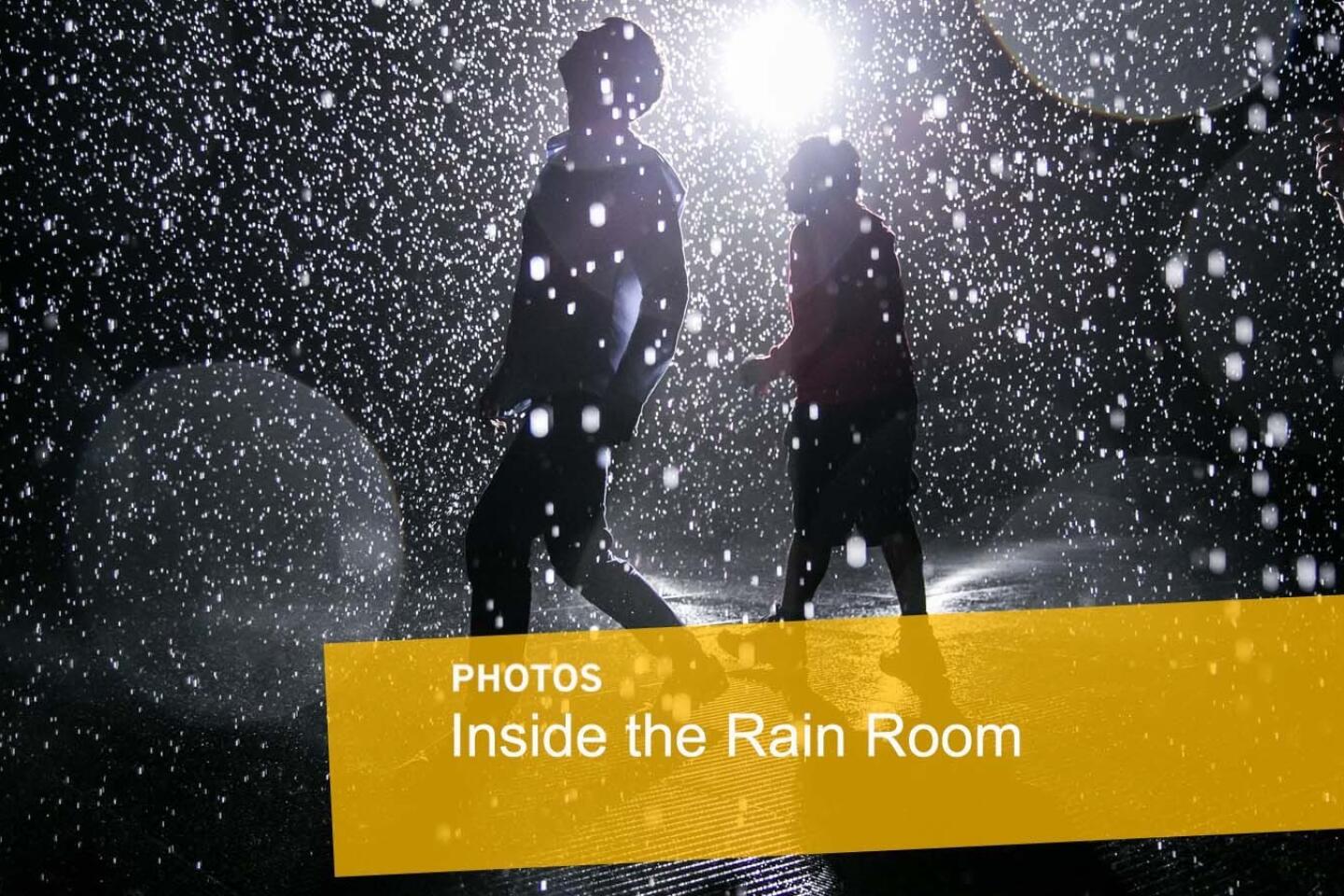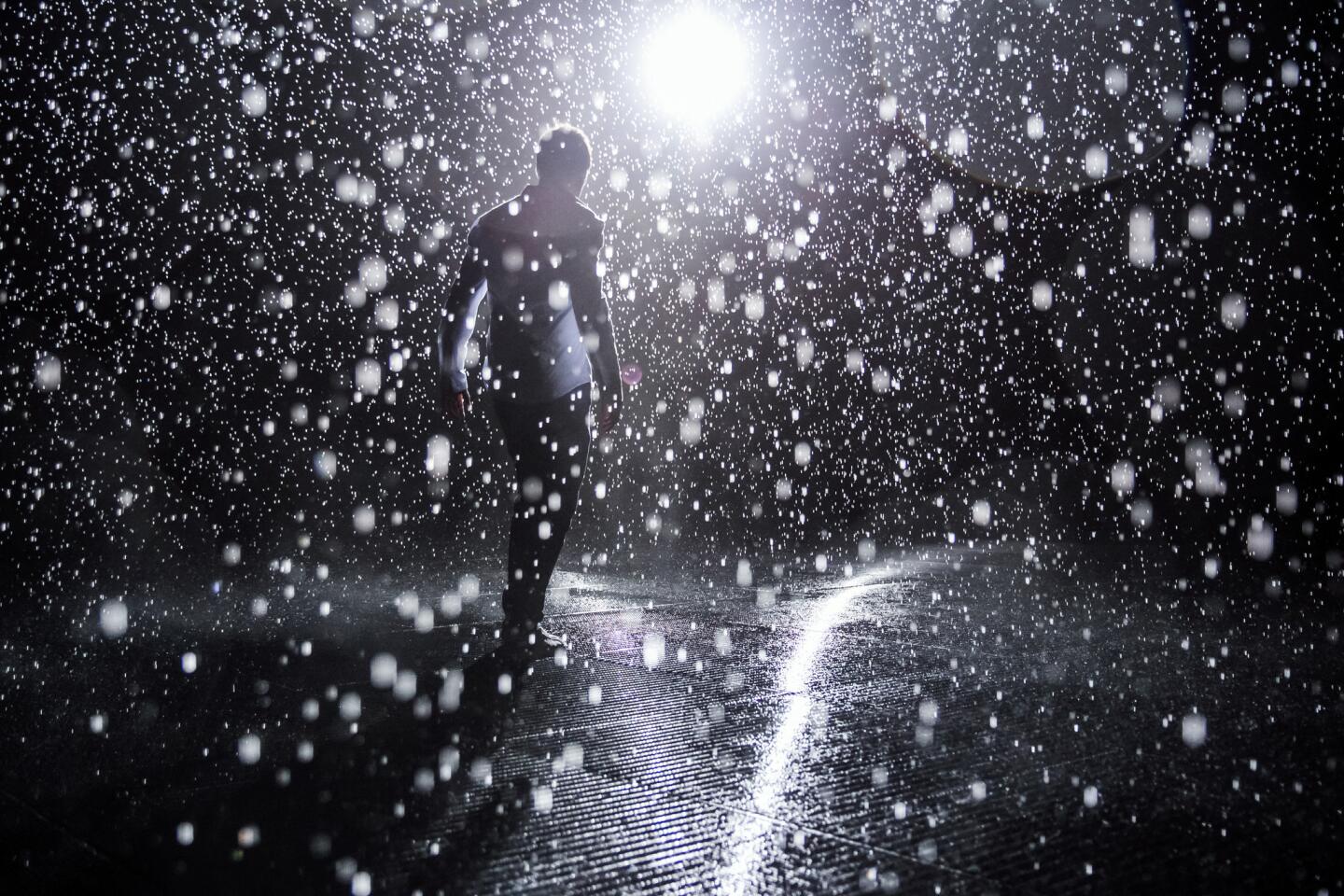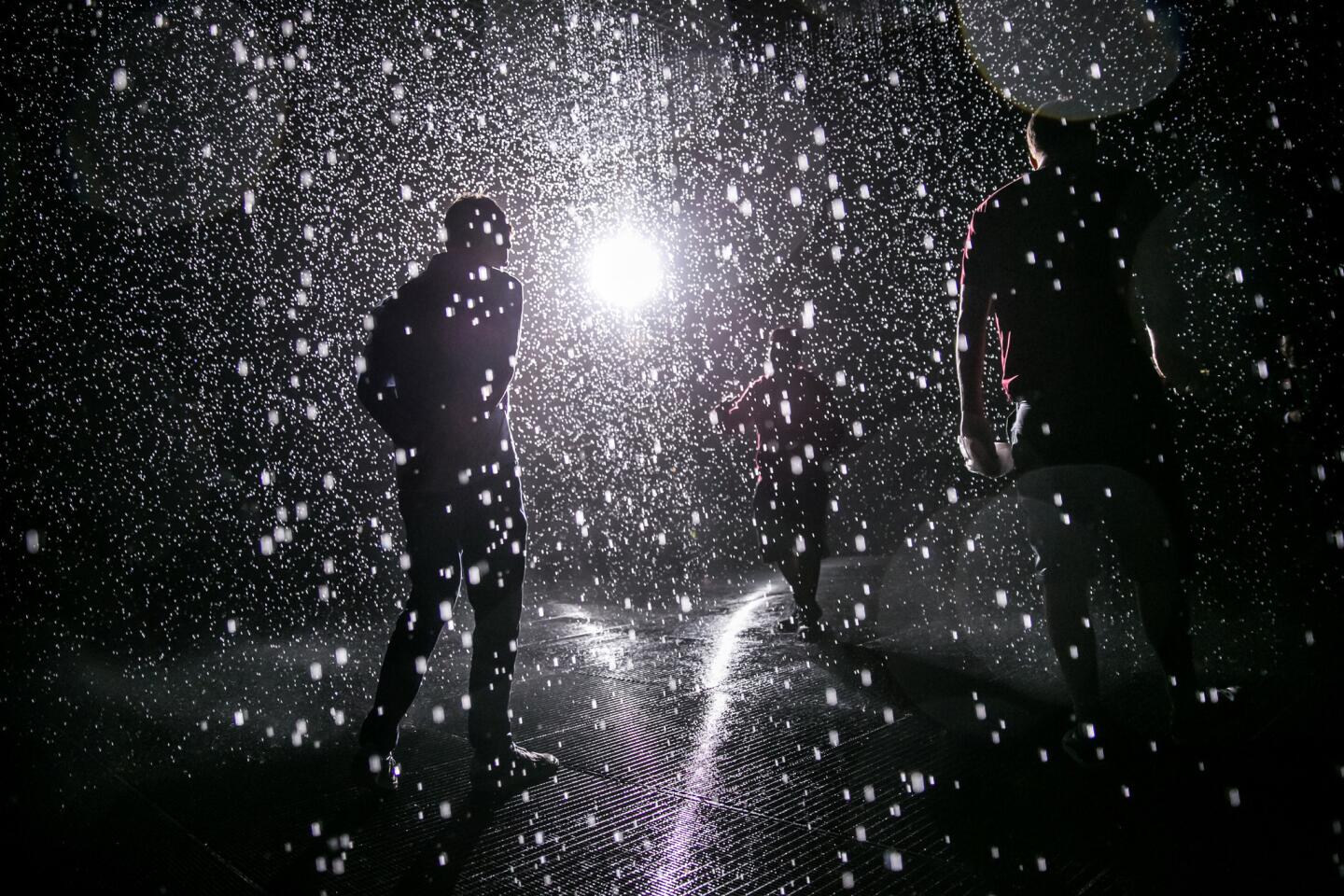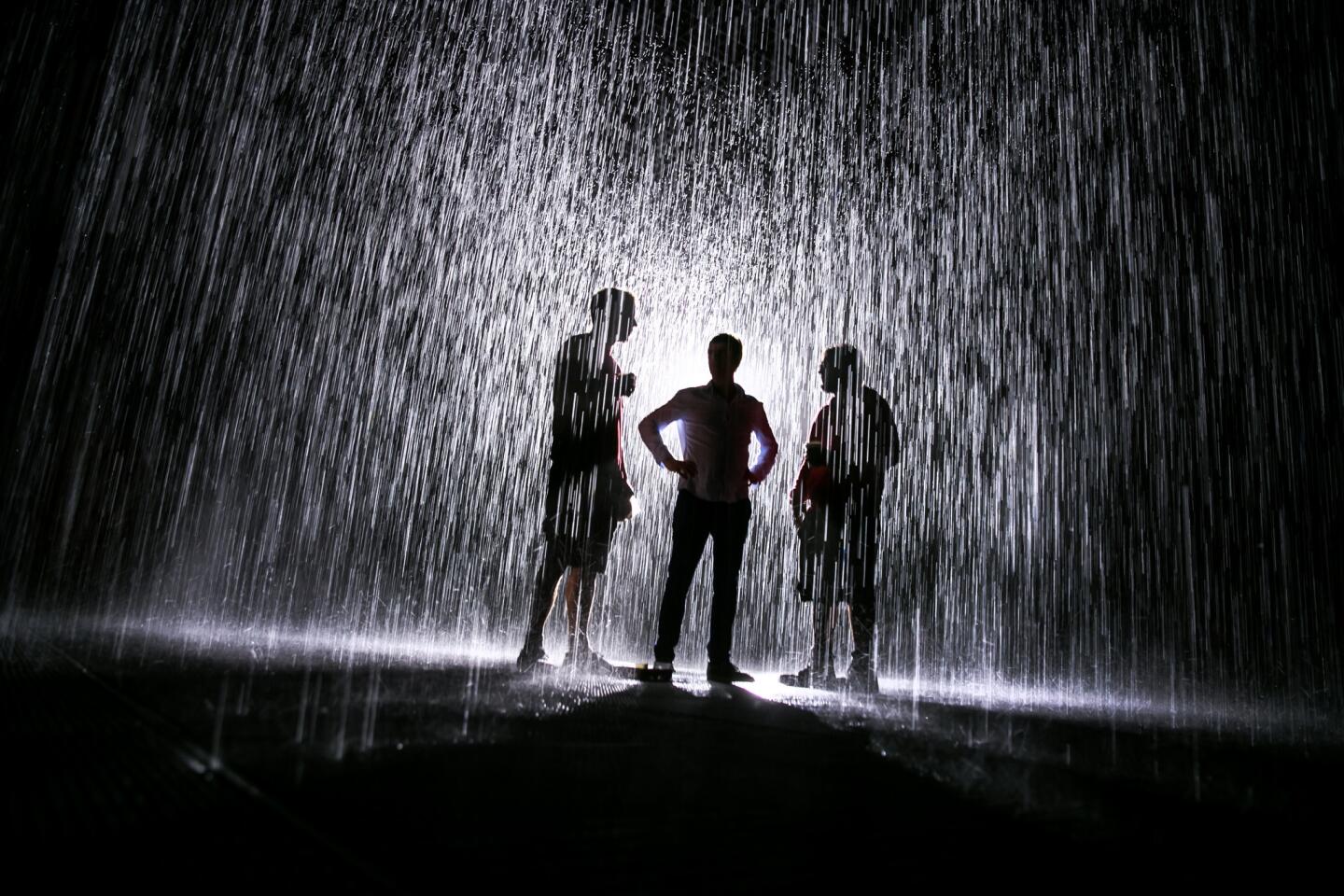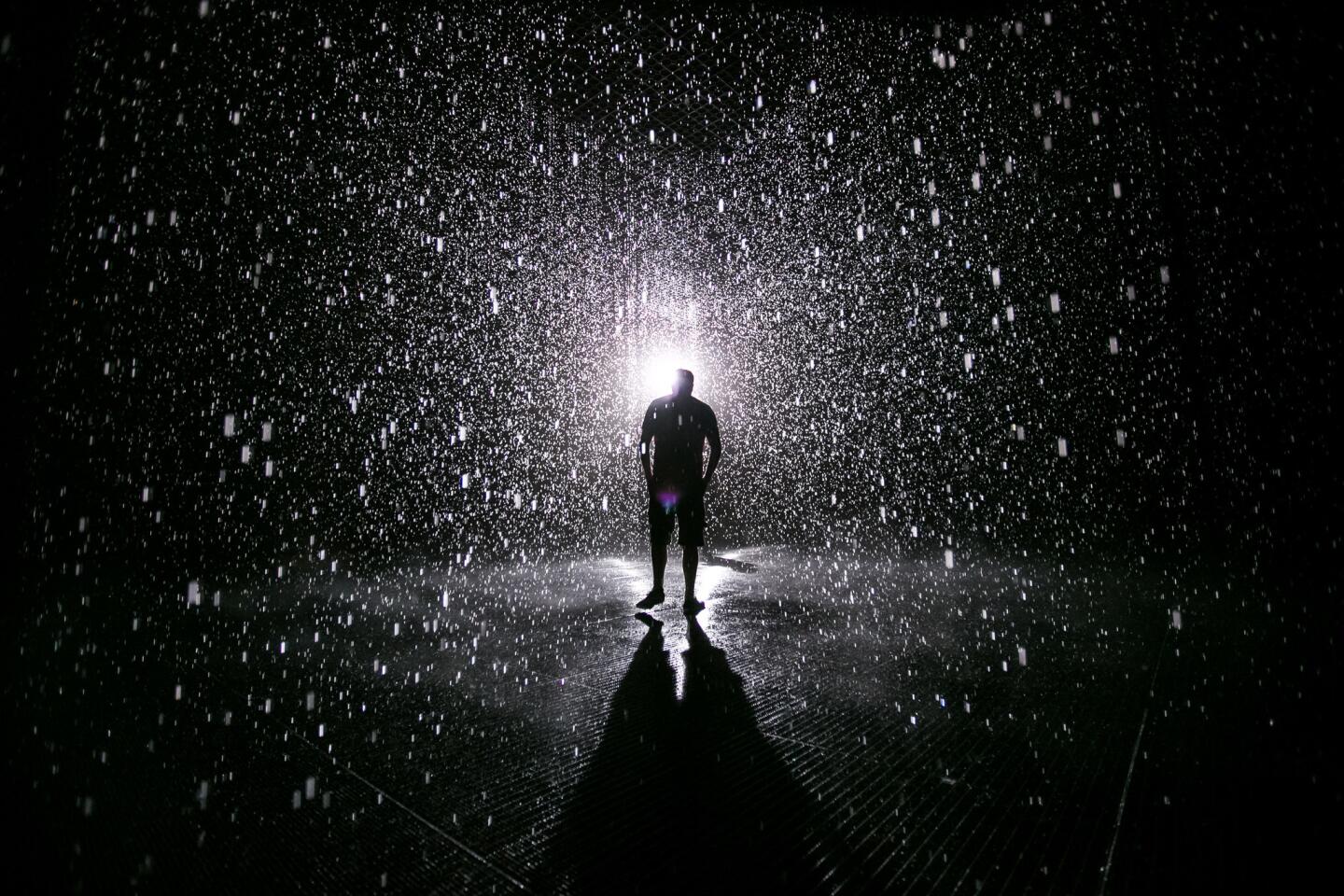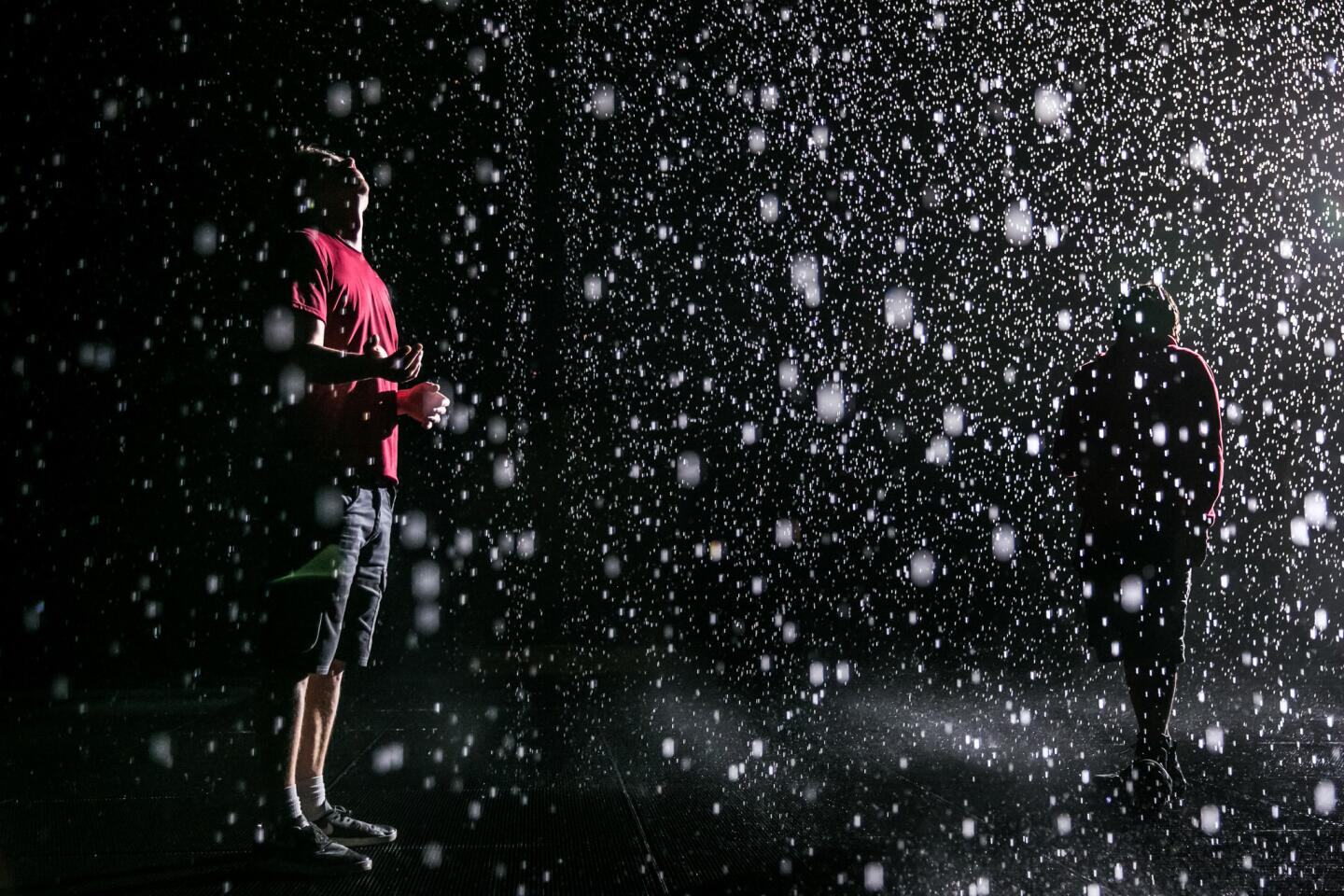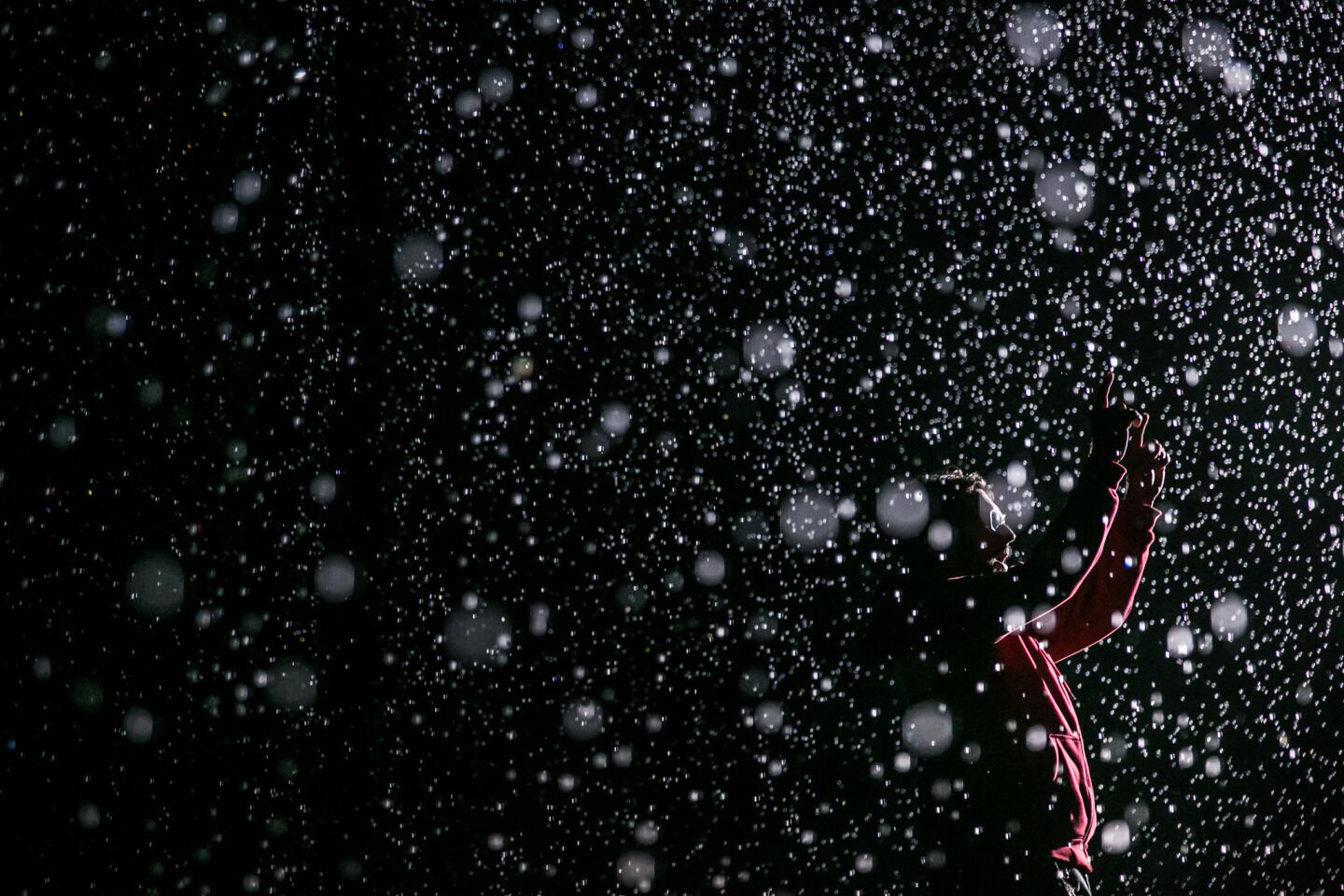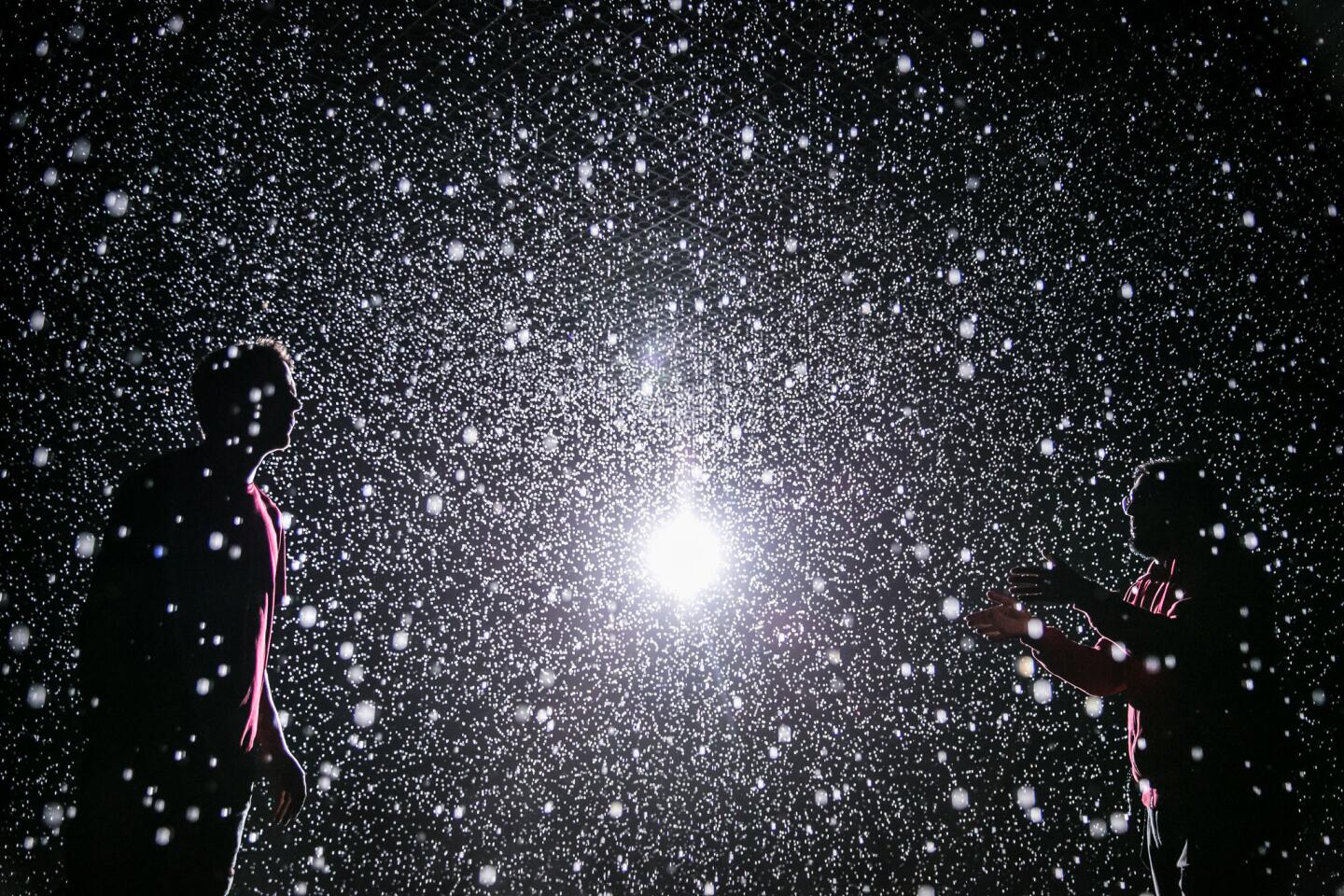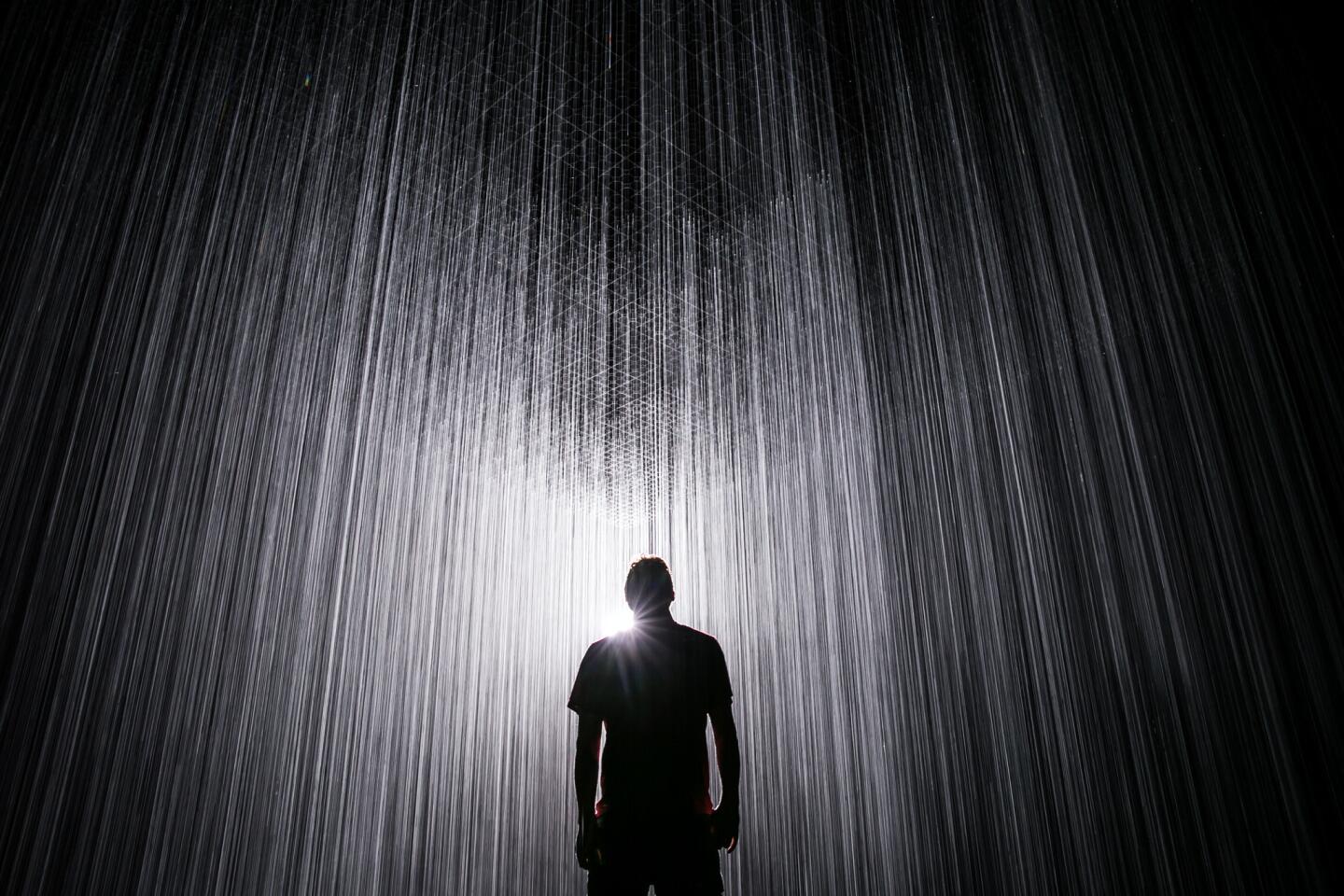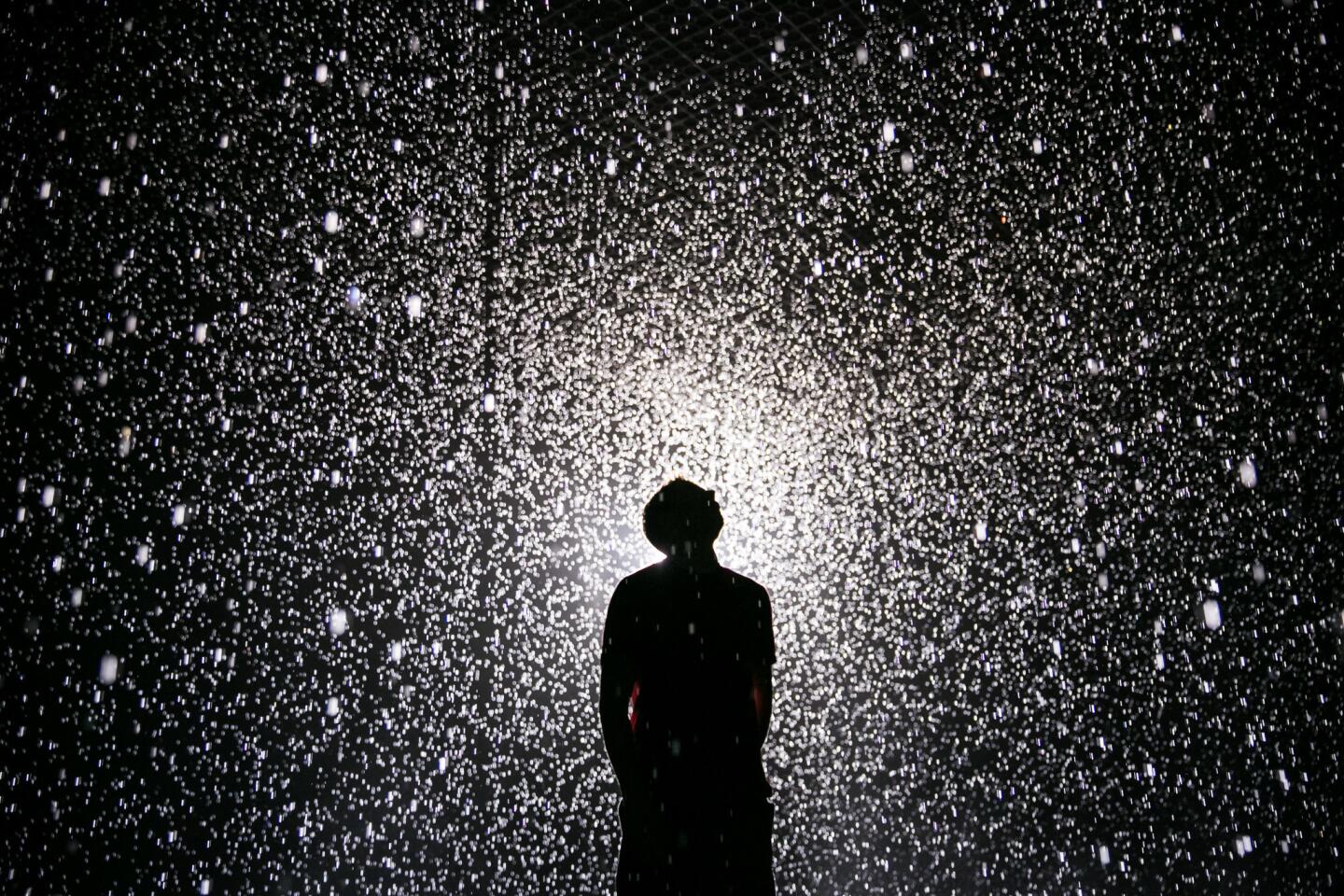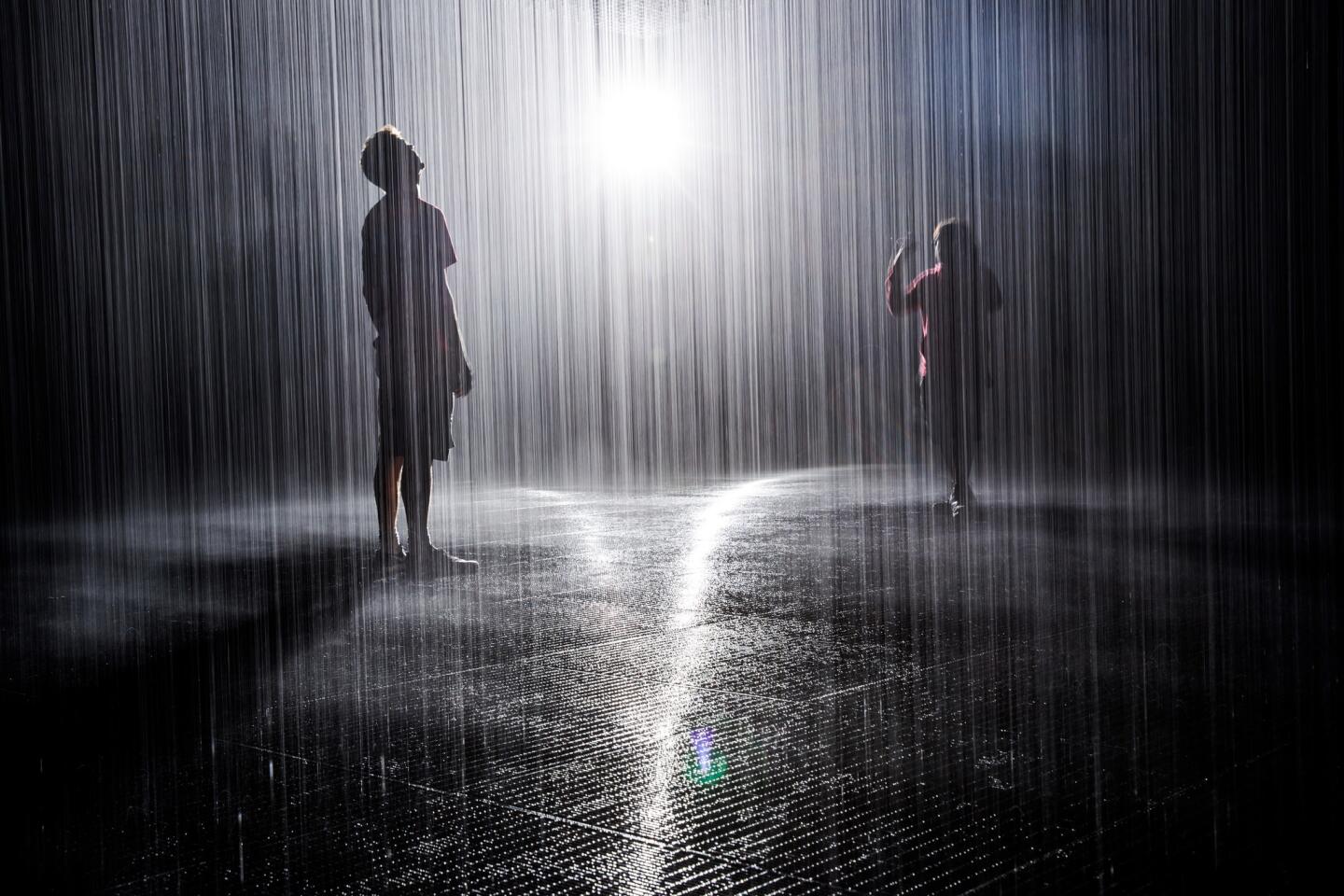First look inside LACMAâs Rain Room: an indoor storm where you wonât get wet...honest
On Sunday, the rains will arrive â slicing the air in great, silvery sheets, hitting the ground with a splash and a deafening whoosh.
Those caught in this particular downpour, however, will remain magically dry.
The Rain Room, an immersive, large-scale light and sound installation, is making its West Coast debut at the Los Angeles County Museum of Art. With some meteorological sleight of hand, visitors wandering throughout the gallery of the Broad Contemporary Art Museum actually control the stormy weather with each footstep.
SIGN UP for the free Essential Arts & Culture newsletter >>
The work, a blend of science, visual art and technology, was created by designers Hannes Koch and Florian Ortkrass, co-founders of the London-based art collective Random International.
The Rain Room debuted at Londonâs Barbican Centre in 2012. When it was shown at New Yorkâs Museum of Modern Art in 2013, it became a crowd favorite and a selfie hot spot. A search on Instagram yields more than 20,000 pictures.

Rain is finally coming to Los Angeles -- unfortunately, not the kind that would reverse the drought. âRain Room,â an elaborate art installation that allows visitors to walk through a simulated downpour, is arriving at the Los Angeles County Museum o
As visitors pass through the installationâs torrent of water, sensors detect their presence and the rain directly above them pauses â thereâs always a roughly six-foot radius of dry clearing around each person. But the rain rages on around them.
A spotlight in one corner of the room illuminates the shimmering raindrops, rendering them almost individually perceptible â from across the room the scene almost looks like snowfall â and against the light, bodies appear in silhouette.
Only seven people are allowed into the rainstorm at any one point, for up to 15 minutes each.
Moving across the wet floor, essentially a 1,500-square-foot metal drain, to the pitter-patter of the rainfall, the effect is both haunting and strikingly beautiful.
Who wouldnât like rain in the middle of Southern California right now? Itâs poetically beautiful, the image just seemed so right.
— LACMA director Michael Govan
Koch and Ortkrass met in college in Britain and share an interest in the California Light and Space movement of the 1960s â including the work of Robert Irwin and James Turrell â as well as a passion for architecture, performance art and a desire to explore the way human beings coexist in an increasingly digital universe.
The Rain Room merges all these elements in an experience that is both sensual and artificial at the same time.
âWeâre exploring the consequences of living in a machine-led world,â Koch said. âIn the Rain Room we amplify one aspect of that, which is a space that permanently sees you and observes you. Itâs a surveillance machine in a way.â
Part of the idea, Koch said, was to explore how people interact with the installation.
âPeople largely experience Rain Room through a screen,â Koch said of visitors using smartphones. âItâs real-time documentation, they film it while they see it; and thatâs something that can be said for lots of areas of life at the moment â it does something to us.â
On a recent private walk-through, Koch walked along the edge of the room, on a dry pathway, as a back-lighted sheath of water fell beside him. He turned to face what looked like a waterfall and stepped into the storm.
As he slowly and cautiously moved deeper and deeper into the downpour, stretching out his arms, palms up â as if feeling for raindrops â the overhead sprinkler heads gently switched off and the storm inched forward, always just inches in front of him. There may have been a drop of water on his shoulder or shoe tip, but otherwise he stayed completely dry.
Just donât wear stripes into the Rain Room â not yet, anyway. The technology responds to the capacity to reflect light in order to detect when bodies are in the waterâs midst, Koch explained. Different fabrics and patterns reflect light at different intensities, and this reporter, wearing a black-and-white striped shirt, learned that the hard way. Stepping into the rain, the sensors didnât recognize the stripes. The result? A downpour on the head.
âToday was a learning experience,â Koch joked. âCheap polyester suits too, itâs not so great with that. Weâre tweaking it.â
By Sunday, the glitches should be worked out, Koch said, and all moving parts in sync. That includes 10 3-D cameras detecting body motion and a custom drop ceiling in the gallery made up of 1,600 tile-like squares, each packed tightly with 36 tiny sprinkler-nozzles releasing rain. Theyâre controlled by computers in a back room that also features a water treatment and recycling system.
Which raises the question: How does LACMA justify featuring a water-dependent installation in a city suffering a persistent drought?
The Rain Room uses about 528 gallons of water, coming from LACMAâs water main; those same 528 gallons will be recycled throughout the exhibition. An inspector will test the water weekly to make sure it stays clean.
âItâs the water footprint of a hamburger,â Koch said. âYou need as much water in Rain Room as you need to make a Big Mac, from feeding the cows, industrial production, growing the lettuce and tomato, the whole process. Itâs basically a couple of bathtubs of water, recycled.â
Developing a conversation around water conservation was one goal of bringing the Rain Room to L.A.
âWe knew drought was a massive issue here,â Koch said. âThe installation is really efficient; think of the impact you can have with this much water compared to the wastefulness in other contexts, like meat production.â
Sound is also central to the artwork, one of the things that inspired Koch and Ortkrass from the onset.
âItâs surreal â rain never sounds like this,â Koch said. âUsually it has roofs or cars to bump on and break it up; here, itâs very stylized, a very monotonous, formalized sound. But itâs a frequency that your brain is permanently looking for. It has a very soothing quality.â
Koch sees each incarnation of the Rain Room as site specific. At MoMA, it was installed in a specially built pavilion. At LACMA, itâs been brought into one of the museumâs permanent galleries, which was slightly more complicated given the space needed and working with the roomâs layout, ceiling height and other infrastructural considerations.
âThe idea was to show it with other artworks,â museum director Michael Govan said. âIf we were going to show it, we wanted to bring it right into the museum where you were thinking about sculpture and paintings â where hopefully it fits, but also looks even more surreal.â
The installation is the first exhibition in the museumâs recently launched 10-year-long âThe Hyundai Project: Art + Technology at LACMA,â which is an outgrowth of LACMAâs 1967-1971 Art and Technology program.
When the opportunity to show the Rain Room first came up earlier this year, Govan said, âwe were just beginning our reconsideration of the art and technology project. Weâd been talking a lot about those issues â Andy Warholâs rain machine, I love that work.
âWhen this came up as a possibility, I thought, âHow perfect.â It merges both art and technology â itâs beautiful and interactive and deals with light, but itâs also technology in the extreme, the magic of technology.â
The Rain Room on view at LACMA is actually one of six, along with two artist proofs (early editions, like prototypes). The one seen at the Barbican in London was the first artist proof, which took about four years to create. The first finished Rain Room â they now take about eight months to build â was sold to Restoration Hardwareâs art initiative RH Contemporary Art, which lent the piece to LACMA. Thatâs also the version shown at MoMA in 2013.
The second one was acquired by an art foundation in the Middle East, though Koch canât reveal its name yet, and the third was purchased by the collector Budi Tekâs Yuz Foundation in Shanghai and will eventually be permanently installed in Tekâs sculpture park in Bali, Indonesia, Koch says.
The other Rain Rooms arenât yet spoken for. Koch says he and Ortkrass hope to install them permanently at art institutions rather than have them tour.
Govan said it was too soon to say whether LACMA might be interested in permanently acquiring the work. In the short term, however, he thinks the Rain Room is perfectly suited for LACMA â and Los Angeles â at the moment.
âWeâre in the middle of a drought,â Govan said. âWho wouldnât like rain in the middle of Southern California right now? Itâs poetically beautiful, the image just seemed so right. Like a rain dance.â
--------------------------
Rain Room
Where: LACMA, 5905 Wilshire Blvd., L.A.
When: SundayâMarch 6; reservations required; check website for ticket times and prices
Info: (323) 857-6000, www.lacma.org
ALSO:
A chilling portrait of Germanyâs Weimar era emerges in âNew Objectivityâ at LACMA
How museums are adapting to âselfie cultureâ
âFrank Gehryâ at LACMA is well framed but still needs build-out
More to Read
The biggest entertainment stories
Get our big stories about Hollywood, film, television, music, arts, culture and more right in your inbox as soon as they publish.
You may occasionally receive promotional content from the Los Angeles Times.
